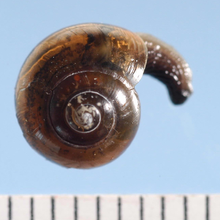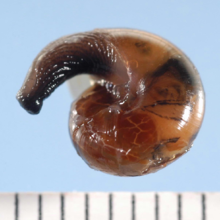- Ovachlamys fulgens
-
Ovachlamys fulgens 
Ovachlamys fulgens Notice the caudal horn on the tail end of the foot. Scientific classification Kingdom: Animalia Phylum: Mollusca Class: Gastropoda (unranked): clade Heterobranchia clade Euthyneura
clade Panpulmonata
clade Eupulmonata
clade Stylommatophora
clade Sigmurethra
clade limacoid cladeSuperfamily: Helicarionoidea Family: Helicarionidae Genus: Ovachlamys Species: O. fulgens Binomial name Ovachlamys fulgens
(Gude, 1900)[1]Synonyms Macrochlamys fulgens Gude, 1900
Ovachlamys fulgens is a species of air-breathing land snail, a terrestrial pulmonate gastropod mollusk in the family Helicarionidae.
Ovachlamys fulgens was originally discovered and described as Macrochlamys fulgens by the British malacologist Gerard Pierre Laurent Kalshoven Gude in 1900.[1]
Contents
Distribution
The type locality for this species is Ryukyu Islands (Loo-Choo Islands).[1] The type specimens are stored in the Florida Museum of Natural History.[2]
The snail is thought to be originally from the Ryukyu Islands.[3]
Ovachlamys fulgens has spread to various countries, most probably accidentally introduced with the orchid trade.[4] Non-indigenous distribution of Ovachlamys fulgens include:
Americas:
- Costa Rica[2][3] The most frequent non-indigenous distribution has this species in Costa Rica.[4]
- USA:
- Miami-Dade County, Florida - it was has been reported since 2003, but its wide distribution in the areas sampled strongly indicates that it has been established in southern Florida for some time.[4]
- Broward County, Florida[3] - it was has been reported since 2003.[4]
- Trinidad[3][4] and Tobago[4]
- Colombia[4]
Pacific:
- Hawaii[4]
Several Southeast Asian countries:
This species is already established in the USA, and is considered to represent a potentially serious threat as a pest, an invasive species which could negatively effect agriculture, natural ecosystems, human health or commerce. Therefore it has been suggested that this species be given top national quarantine significance in the USA.[5]
Description
 The drawings in the type description were created by the illustrator John Nugent Fitch and show apical, apertural and umbilical views of the shell of Ovachlamys fulgens.
The drawings in the type description were created by the illustrator John Nugent Fitch and show apical, apertural and umbilical views of the shell of Ovachlamys fulgens.
The shell of this species is perforate, trochoid, thin, shining, pellucid and dark corneous.[1] The spire is depressed.[1] The apex is obtuse.[1] Sutures are linear and margined.[1] The shell has four whorls, that are increasing rather suddenly.[1] The last whorl is convex and a little inflated and it is twice as wide as the penultimate whorl.[1] Whorls are finely striated, decussated by microscopic spiral lines.[1] The last whorl is not descending and it is slightly excavated in the umbilical region.[1]
The aperture is slightly oblique, lunate.[1] The peristome is thin, straight, acute.[1] Margins of the paerture are distant, sub-parallel, the columellar margin a little reflected and nearly covering the very narrow umbilical perforation.[1]
The width of the shell is 6–7 mm.[1] The height of the shell is 4,5 mm.[1]
These snails are sometimes called "jumping snails" because the tail is modified with a caudal horn and the posterior part of the foot acts as a catapult to push off from contiguous substrates allowing the snail to suddenly move several inches.[3]
Ecology
The habitats of Ovachlamys fulgens include pastures and crop fields with enough moisture and with deep leaf litter cover.[2] For example, habitats with Yucca guatemalensis provide good conditions for this species.[2] The snails are mostly found in soil litter and on plants up to 8 feet in height in areas of secondary growth and tree plantations.[3] Ideal collecting time is after rainfall.[3]
This species is considered an important orchid pest.[3] It is phytophagous[4] and is reported to attack a wide variety of horticultural plants, but the snails are mostly found among soil litter and become dormant during dry periods.[3] It has been found on avocado, mango, Heliconia and Dracaena.[3] Leaves of the avocado can be also used to raise juveniles in the laboratory.[6]
Little scientific data has been gathered on the biology of this species.[3]
Individuals ofOvachlamys fulgens can lay eggs at the age of 42 days and are considered mature when their shell width reaches 5.12 mm.[6] There is no need for the snails to mate in order to lay eggs and for successful reproduction.[6] Eggs are laid in clutches of three in soil or leaf litter where they absorb more water from the environment.[6]
The lifespan of Ovachlamys fulgens is 9 months in the laboratory.[6]
References
This article incorporates public domain text from the reference [1] and a public domain work of the United States Government from references.[3][4]
- ^ a b c d e f g h i j k l m n o p q
 Gude G. K. (1900). "Further notes on helicoid land shells from Japan, the Loo-Choo, and Bonin Islands, with descriptions of seven new species". Proceedings of the Malacological Society of London 4: 70-80. page 75. Table VIII, figure 24-26.
Gude G. K. (1900). "Further notes on helicoid land shells from Japan, the Loo-Choo, and Bonin Islands, with descriptions of seven new species". Proceedings of the Malacological Society of London 4: 70-80. page 75. Table VIII, figure 24-26. - ^ a b c d (Spanish) Barrientos Z. (24 September 1999). "Ovachlamys fulgens (Gude, 1900)". Instituto Nacional de Biodiversidad (INBio), accessed 27 August 2010.
- ^ a b c d e f g h i j k l
 Stange L. A. (created September 2004, updated March 2006). "Snails and Slugs of Regulatory Significance to Florida". Division of Plant Industry, Florida Department of Agriculture and Consumer Services. accessed 27 August 2010.
Stange L. A. (created September 2004, updated March 2006). "Snails and Slugs of Regulatory Significance to Florida". Division of Plant Industry, Florida Department of Agriculture and Consumer Services. accessed 27 August 2010. - ^ a b c d e f g h i j k l
 Robinson D. G. (16 June 2003). "Invasive Mollusk Survey of Miami-Dade and Broward Counties, Florida June 2003". Division of Plant Industry, Florida Department of Agriculture and Consumer Services. PDF.
Robinson D. G. (16 June 2003). "Invasive Mollusk Survey of Miami-Dade and Broward Counties, Florida June 2003". Division of Plant Industry, Florida Department of Agriculture and Consumer Services. PDF. - ^ Cowie R. H., Dillon R. T., Robinson D. G. & Smith J. W. (2009). "Alien non-marine snails and slugs of priority quarantine importance in the United States: A preliminary risk assessment". American Malacological Bulletin 27: 113-132. PDF.
- ^ a b c d e Barrientos Z. (1998). "Life history of the terrestrial snail Ovachlamys fulgens (Stylommatophora: Helicarionidae) under laboratory conditions". Revista de Biología Tropical 46(2): 369-384. PDF. HTM in the Google chache.
Further reading
- (Spanish) Barrientos Z. (1996). "Distribución y ciclo de vida del caracol terrestre Ovachlamys fulgens (Gude, 1900) (Stylommatophora: Helicarionidae)". M.Sc. Thesis, Universidad de Costa Rica, San José, Costa Rica.
External links
- Ovachlamys fulgens at National Center for Biotechnology Information (NCBI) website.
- Ovachlamys fulgens on the UF / IFAS Featured Creatures Web site
Categories:
Wikimedia Foundation. 2010.


